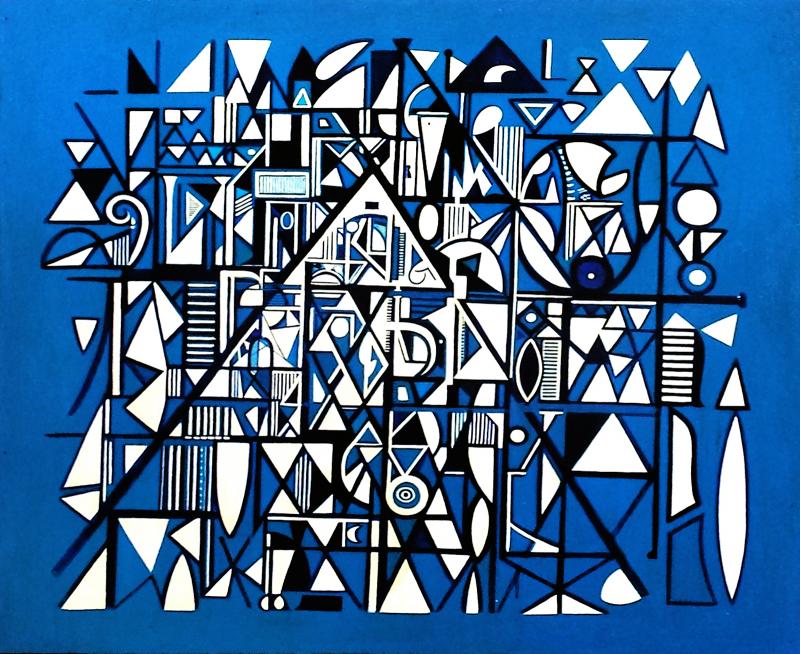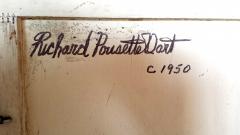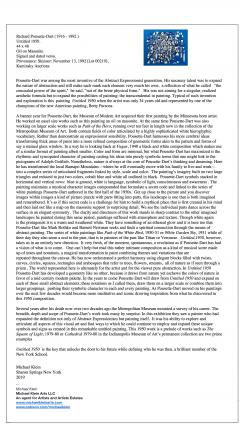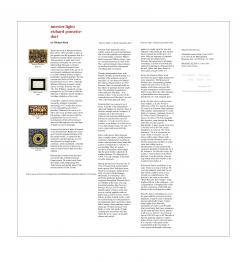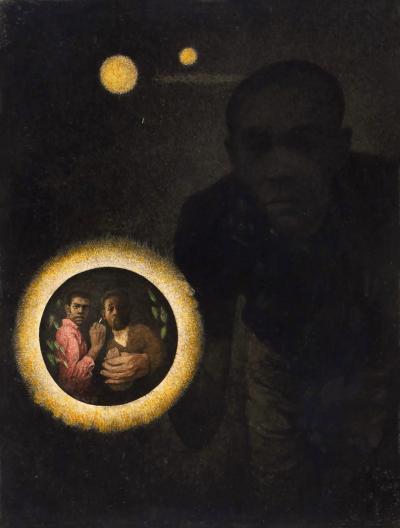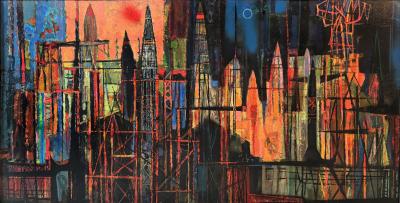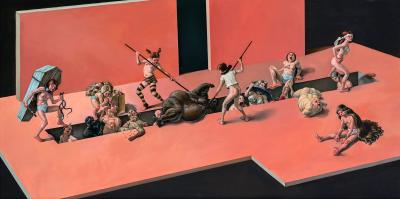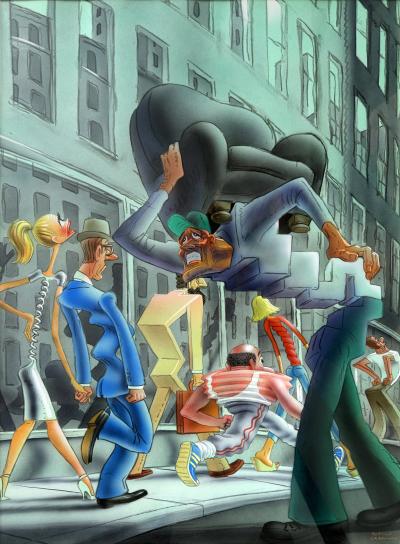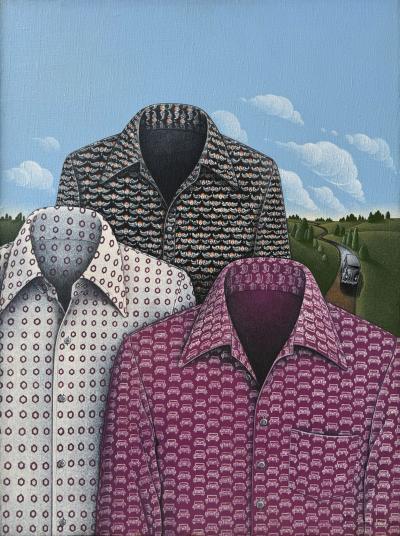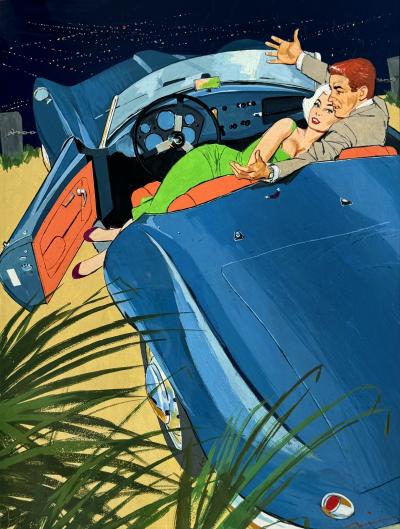Untitled
-
Description
Oil on masonite. This is a pivotal work in deep and radiant cobalt blue from 1950. It dipicts calligraphic and hieroglyph structures over a grid and pyramidal base by the first generation abstract expressionist.
Provenace: Skinner: November 13, 1992 [Lot 00219}, Kaminsky Auctions
Pousette-Dart was among the most inventive of the Abstract Expressionist generation, His uncanny talent was to expand the nature of abstraction and still make each mark each element very much his own; a reflection of what he called "the concealed power of the spirit," he said, “not of the brute physical form." His was not aiming for a singular, realized aesthetic formula but to expand the possibilities of painting; the transcendental in painting. Typical of such invention and exploration is this painting Untitled 1950 when the artist was only 34 years old and represented by one of the champions of the new American painting, Betty Parsons.
?A banner year for Pousette-Dart, the Museum of Modern Art acquired their first painting by the Minnesota born artist. He worked on easel size works such as this painting an oil on masonite. At the same time Pousette-Dart was also working on larger scale works such as Path of the Hero, running over ten feet in length now in the collection of the Metropolitan Museum of Art. Both contain fields of color articulated by a highly sophisticated white hieroglyphic vocabulary. Rather than demonstrate an expressionist sensibility, Pousette-Dart harnesses his more cerebral ideas transforming thick areas of paint into a more refined composition of geometric forms akin to the pattern and forms of say a stained glass window. In a way he is looking back at Fugue, 1940 a black and white composition which makes use of a similar format of painting albeit smaller. Color and form are minimal, but what Pousette-Dart has maximized is the rhythmic and syncopated character of painting casting his ideas into purely symbolic terms that one might link to the pictograms of Adolph Gottlieb. Nonetheless, nature is always at the core of Pousette-Dart’s thinking and dreaming. Here he has transformed the local Ramapo Mountains—where he will eventually move with his family to live and work— into a complex series of articulated fragments linked by style, scale and color. The painting’s imagery built on two large triangles and reduced to just two colors, cobalt blue and white all outlined in black. Pousette-Dart symbols stacked in horizontal and vertical rows: blue is ground, white is language, symbolic of light, consciousness and awareness . The painting maintains a mystical character images compounded that formulate a secret code and linked to the series of white paintings Pousette-Dart authored in the first half of the 1950s. Get up close to the picture and you discover images within images a kind of picture puzzle with parts fitting into parts, this landscape is one that is both imagined and remembered. It’s as if this secret code is a challenge for him to build a mythical place that is first created in his mind and then laid out like a map on the masonite support in surprising detail. We see the individual parts dance across the surface in an elegant symmetry. The clarity and directness of this work stands in sharp contrast to the other imagined landscapes he painted during this same period, paintings suffused with atmosphere and texture. Though white again is the protagonist it is a warm and weathered white. They have something of an ethereal glow and it is here too that Pousette-Dart like Mark Rothko and Barnett Newman seeks and finds a spiritual connection through the means of abstract painting. The series of white paintings like Path of the White Bird, 1950-51 or White Garden Sky, 1951 while of their day they also seem a nod to the past, that is to painters of the past like Titian or Veronese. Untitled,1950, however, takes us in an entirely new direction. It very fresh, of the moment, spontaneous, a revelation as if Pousette-Dart has had a vision of what is to come. One can’t help but read this rather intimate composition as a kind of musical score made up of notes and notations, a magical transformation in paint combining themes and variations that are repeated throughout the canvas. He has now orchestrated a perfect harmony using elegant blocks filled with twists, curves, circles, squares, rectangles and arabesques that refer to trees, flowers, streams, all of nature as if seen through a prism . The world represented here is ultimately for the artist and for the viewer pure abstraction. In Untitled 1950 Pousette-Dart has developed a geometry like no other, because it draws from nature yet eschews the colors of nature in favor of a mid century modern palette. In the years to come Pousette-Dart will draw from Untitled 1950 and expand on each of these small abstract elements, these notations as I called them, draw them on a larger scale or combine them into larger groupings; pushing their symbolic character in each and every painting. As Pousette-Dart moved on his paintings over the next few decades would become more meditative and iconic drawing inspiration from what he discovered in this 1950 composition.
?Several years after his death now over two decades ago the Metropolitan Museum mounted a survey of his career. The breadth, depth and scope of Pousette-Dart’s work took many by surprise. In this exhibition they saw a painter who had expanded the definition not only of Abstract Expressionism but painting itself. It was his ability to explore and articulate all aspects of this visual art and find ways in which he could continue to employ and expand these unique symbols and signs as created in this remarkable untitled painting. This 1950 work is a prelude of works such as The Square of Light, 1979-80 or Cathedral 1979-80 in the Indianapolis Museum of Art’s permanent collection are two prime examples
?Untitled 1950 is the key that unlocks the door to his future while defining who he was then, a brilliant member of the New York School.
( Michael Klein knew Pousette-Dart personally as well as his daughter Joanna and visited his studio in Rockland country, several times between 1985 and 1988 )
?Michael Klein
Sharon Springs New York
2019
Michael Klein
Michael Klein Arts LLC
An agent for Artists and Artists Estates -
More Information
Documentation: Signed Period: 1950-1979 Condition: Good. some light craqueleur upper edges of work. Otherwise, present very well in person with bold saturated colbalt blue Creation Date: 1950 Styles / Movements: Color Field, Conceptualism, Abstract Expressionism Catalog References: Provenace: Skinner: November 13, 1992 [Lot 00219}, Kaminsky Auctions Incollect Reference #: 331487 -
Dimensions
W. 44 in; H. 48 in; W. 111.76 cm; H. 121.92 cm;
Message from Seller:
Robert Funk Fine Art in Miami offers an eclectic collection shaped by 45 years of experience, blending art with commercial perspectives. For inquiries or art advisory services, contact Robert Funk at decoypoet@yahoo.com or 305.857.0521.















